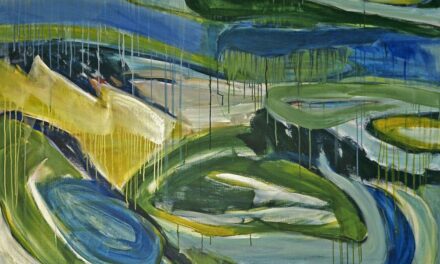Caspar David Friedrich was born on 5 September 1774 in Greifswald, a town in the Kingdom of Prussia, now part of Germany. He was the sixth of ten children born to Adolf Gottlieb Friedrich, a soap boiler, and Sophie Dorothea Bechly. Friedrich’s early life was marked by tragedy, as he lost his mother at a young age and his father passed away when he was just 13 years old.
Following his father’s death, Friedrich was taken in by his uncle, who recognised his artistic talent and encouraged him to pursue a career in art. Friedrich’s early influences included the natural beauty of the German countryside, which would later become a central theme in his work. He studied under the landscape painter Johann Gottfried Quistorp in Greifswald, where he developed a deep appreciation for the power and majesty of nature.
Friedrich’s early experiences with loss and the sublime beauty of the natural world would go on to shape his artistic vision and inspire some of his most iconic works. Friedrich’s formative years were also marked by the political and social upheaval of the Napoleonic Wars, which had a significant impact on his worldview and artistic sensibilities. The tumultuous events of the time would later find expression in his paintings, which often conveyed a sense of melancholy and introspection.
These early experiences and influences laid the foundation for Friedrich’s unique style and thematic preoccupations, which would come to define him as one of the leading figures of the Romantic movement in art.
Summary
- Caspar David Friedrich was born in Greifswald, Germany in 1774 and was influenced by the natural beauty of the Baltic coast.
- His style focused on the sublime and the spiritual, often featuring solitary figures in contemplative landscapes.
- Friedrich’s work was a key part of the Romantic movement, influencing artists such as Turner and Delacroix.
- Some of his most famous works include “Wanderer above the Sea of Fog” and “The Sea of Ice”.
- Friedrich’s legacy continues to influence modern art, with his emphasis on emotion and nature still resonating with artists today.
Style and Themes
The Sublime in Friedrich’s Art
One of the central themes in Friedrich’s art is the idea of the “sublime,” which refers to the overwhelming power and grandeur of nature that elicits feelings of awe, fear, and reverence. His paintings often depict solitary figures contemplating vast and awe-inspiring landscapes, conveying a sense of the individual’s insignificance in the face of nature’s immensity. This theme reflects Friedrich’s deep spiritual beliefs and his fascination with the transcendent power of the natural world.
Symbols and Allegory
Another recurring motif in Friedrich’s work is the use of symbolism to convey deeper philosophical and spiritual meanings. For example, the use of specific elements such as crosses, ruins, and solitary trees often carry symbolic significance, representing themes of mortality, spirituality, and the passage of time. Friedrich’s paintings are rich with allegorical imagery that invites viewers to contemplate the deeper meanings behind his evocative landscapes, making his work both visually captivating and intellectually stimulating.
Emotional and Spiritual Resonance
Friedrich’s paintings are not only visually stunning but also emotionally and spiritually resonant. His use of light, colour, and composition creates a sense of atmosphere that draws the viewer in, inviting them to contemplate the deeper meanings and emotions evoked by his work. As such, Friedrich’s paintings continue to captivate audiences to this day, offering a profound and thought-provoking experience that lingers long after the initial viewing.
Romanticism and Friedrich’s Impact

Caspar David Friedrich is widely regarded as one of the leading figures of the Romantic movement in art, which emerged in Europe in the late 18th century as a reaction against the rationalism and order of the Enlightenment. Romanticism placed a strong emphasis on emotion, imagination, and the sublime beauty of nature, seeking to evoke powerful emotional responses in viewers. Friedrich’s work exemplifies these ideals, as his paintings are imbued with a sense of mystery, melancholy, and spiritual transcendence that resonated deeply with the Romantic sensibility.
Friedrich’s impact on Romanticism was profound, as his art came to epitomize the movement’s preoccupation with nature, spirituality, and the individual’s inner world. His paintings captured the essence of Romantic ideals, conveying a sense of longing for the infinite, a reverence for nature’s beauty, and a fascination with the mysterious and unknowable aspects of existence. Friedrich’s work inspired a generation of artists who sought to explore similar themes in their own art, making him a central figure in the development of Romantic landscape painting.
Friedrich’s influence extended beyond his contemporaries and had a lasting impact on subsequent generations of artists, particularly in Germany and Scandinavia. His evocative depictions of nature and his exploration of existential themes resonated with artists such as Johan Christian Dahl and Carl Gustav Carus, who further developed and expanded upon Friedrich’s artistic legacy. Friedrich’s contributions to Romanticism helped shape the trajectory of landscape painting in the 19th century and continue to inspire artists to this day.
Famous Works and Iconic Paintings
Caspar David Friedrich created a vast body of work that includes some of the most iconic paintings in the history of art. Among his most famous works is “Wanderer above the Sea of Fog” (1818), which has become an enduring symbol of Romanticism. The painting depicts a lone figure standing on a rocky precipice, gazing out at a sea of mist-shrouded mountains.
The image conveys a sense of awe and contemplation, capturing the essence of Friedrich’s fascination with the sublime beauty of nature. Another renowned painting by Friedrich is “The Sea of Ice” (1823-1824), which portrays a desolate Arctic landscape dominated by a massive iceberg. The painting conveys a sense of foreboding and isolation, with its stark imagery evoking themes of existential struggle and human vulnerability in the face of nature’s power.
“The Abbey in the Oakwood” (1809-1810) is another iconic work by Friedrich, depicting a ruined abbey surrounded by gnarled oak trees against a backdrop of darkening skies. The painting conveys a haunting sense of decay and transience, reflecting Friedrich’s preoccupation with mortality and spiritual transcendence. Friedrich’s paintings are celebrated for their evocative imagery, meticulous attention to detail, and profound emotional resonance.
His iconic works continue to captivate viewers with their timeless beauty and enduring relevance, cementing Friedrich’s status as one of the most influential artists of the Romantic era.
Friedrich’s Legacy and Influence on Modern Art
Caspar David Friedrich’s legacy extends far beyond his own lifetime, as his impact on modern art continues to be felt to this day. His innovative approach to landscape painting and his exploration of existential themes have inspired countless artists across different movements and periods. Friedrich’s emphasis on emotion, spirituality, and the sublime beauty of nature has left an indelible mark on the development of landscape painting and has influenced generations of artists who sought to capture similar themes in their work.
Friedrich’s influence can be seen in the work of artists such as Edvard Munch, whose haunting depictions of nature and existential angst bear echoes of Friedrich’s own artistic vision. The Symbolist movement also drew inspiration from Friedrich’s use of symbolism and allegory to convey deeper philosophical meanings in art. In addition, Friedrich’s impact on German Romanticism paved the way for subsequent generations of artists who sought to explore similar themes in their own work.
In more recent times, Friedrich’s legacy has been celebrated through exhibitions and scholarly studies that seek to re-evaluate his contributions to art history. His paintings continue to be revered for their timeless beauty and profound emotional resonance, attracting new generations of admirers who are captivated by Friedrich’s unique vision and enduring relevance.
Personal Life and Tragic Events

Early Relationship and Marriage
In 1798, he became engaged to Caroline Bommer, but their relationship faced numerous obstacles due to financial difficulties and family opposition. The couple eventually married in 1818 after years of struggle, but their marriage was marred by further hardships, including financial instability and personal loss.
Personal Tragedies
The couple had three children, but only one survived into adulthood. Friedrich also faced personal tragedy with the death of his beloved brother Christian in 1801, which had a profound impact on him both emotionally and artistically. The loss of his brother deepened Friedrich’s sense of melancholy and introspection, influencing the themes and mood of his later works.
Professional Setbacks and Artistic Legacy
In addition to these personal losses, Friedrich also experienced professional setbacks, including declining popularity towards the end of his life due to changing artistic tastes. Despite these challenges, Friedrich remained dedicated to his artistic vision and continued to produce evocative paintings that captured the essence of Romanticism. His personal struggles only served to deepen his artistic sensibilities, leading to some of his most profound and introspective works that continue to resonate with viewers today.
Recognition and Appreciation in the Art World
Caspar David Friedrich’s contributions to art have been widely recognised and appreciated in the art world since his lifetime. Although he faced declining popularity towards the end of his career due to changing artistic tastes, Friedrich’s work has since been re-evaluated and celebrated for its enduring significance. In recent decades, there has been a renewed interest in Friedrich’s art, with major exhibitions dedicated to his work attracting large audiences around the world.
Friedrich’s paintings are now considered masterpieces that have had a lasting impact on the development of landscape painting and Romanticism. His evocative imagery, profound emotional resonance, and innovative approach to capturing the sublime beauty of nature have solidified his status as one of the most influential artists of his time. Friedrich’s legacy continues to be celebrated through scholarly studies, museum exhibitions, and critical acclaim that reaffirm his place as a pioneering figure in art history.
In addition to his enduring influence on art history, Friedrich’s impact can also be seen in popular culture, with his iconic paintings being referenced in literature, music, film, and other forms of media. His evocative imagery continues to captivate audiences across different generations, reaffirming Friedrich’s status as an artist whose work transcends time and continues to inspire new generations of artists and admirers alike.
If you are interested in learning more about different art movements, you may want to check out an introduction to post-impressionism. This article explores the work of artists such as Vincent van Gogh and Paul Cézanne, and how they moved away from the naturalism of impressionism to explore more abstract and symbolic forms of expression. You can read more about it here.
FAQs
Who is Caspar David Friedrich?
Caspar David Friedrich was a 19th-century German Romantic landscape painter, considered one of the most important figures in the movement. He is known for his contemplative and symbolic landscapes, often featuring solitary figures in the midst of nature.
What is Caspar David Friedrich known for?
Caspar David Friedrich is known for his atmospheric and emotive landscapes, which often convey a sense of spirituality and the sublime. His work is characterized by a focus on nature, with an emphasis on the individual’s relationship to the natural world.
What are some famous works by Caspar David Friedrich?
Some of Caspar David Friedrich’s most famous works include “Wanderer above the Sea of Fog,” “The Sea of Ice,” and “The Abbey in the Oakwood.” These paintings are emblematic of Friedrich’s style and themes, featuring dramatic landscapes and a sense of introspection.
What influence did Caspar David Friedrich have on art?
Caspar David Friedrich’s work had a significant impact on the development of Romanticism and landscape painting. His emphasis on the individual’s experience of nature and the spiritual aspects of the natural world influenced later generations of artists, including the Symbolists and the Expressionists.
Where can I see Caspar David Friedrich’s paintings?
Many of Caspar David Friedrich’s paintings are housed in museums across Europe, particularly in Germany. The Alte Nationalgalerie in Berlin and the Hermitage Museum in St. Petersburg, Russia, are notable institutions that hold significant collections of Friedrich’s work.




